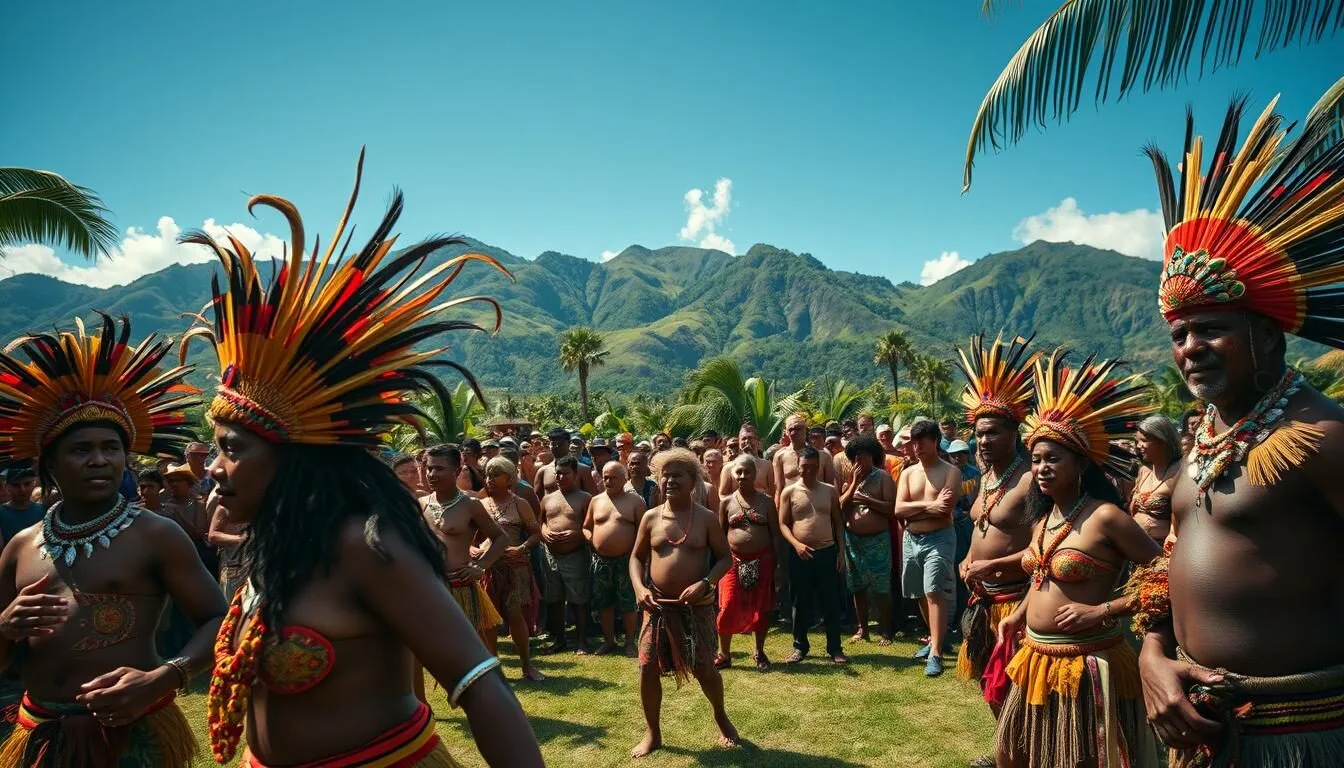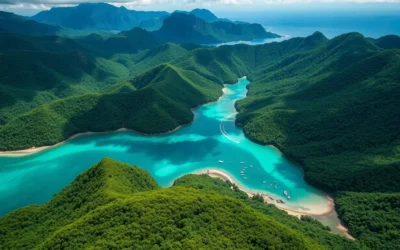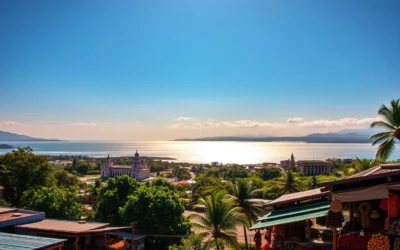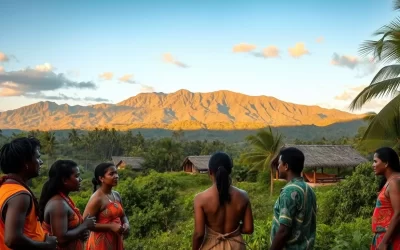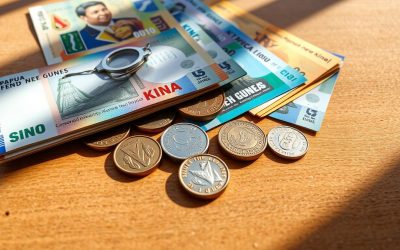✓ Accommodations ✓ Flights ✓ Rental Cars ✓ Tours & Activities
Imagine attending a festival where over 100 tribal groups come together to celebrate their rich heritage. With more than 840 indigenous languages spoken across the island, Papua New Guinea is a land of incredible cultural diversity.
You can experience this vibrant culture firsthand by visiting during one of the many colorful festivals that take place throughout the year. These events showcase traditional music, ceremonial dances, and elaborate costumes, offering a unique glimpse into the lives of the local people.
By timing your visit around these festivals, you’ll have the opportunity to witness Papua New Guinea’s living heritage and create unforgettable memories.
The Cultural Tapestry of Papua New Guinea
Papua New Guinea’s cultural landscape is characterized by its remarkable diversity, with over 840 indigenous languages spoken across the country. This diversity is a testament to the rich cultural heritage and traditions that thrive in this Pacific nation.
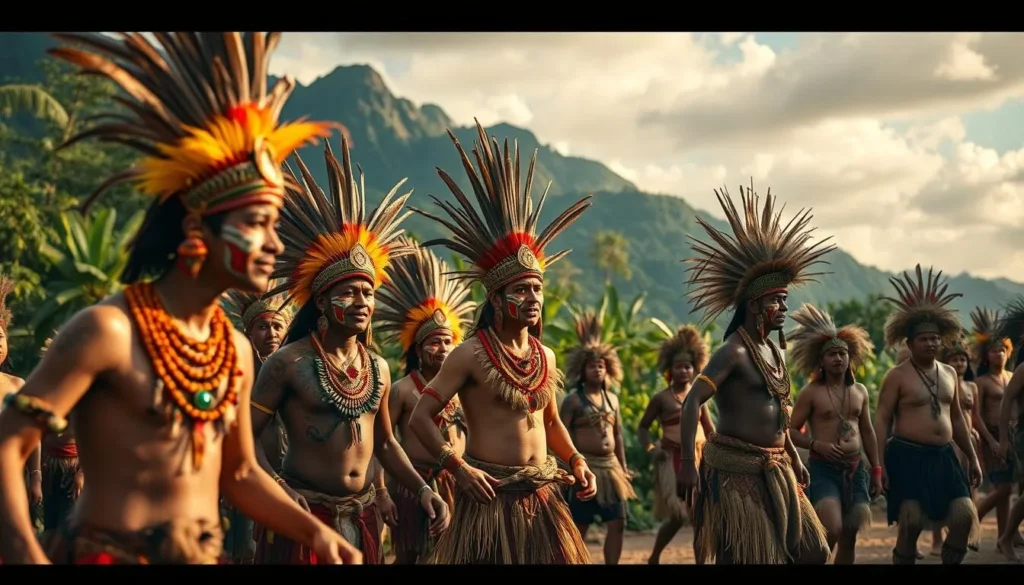
A Land of 840+ Indigenous Languages
The presence of over 840 indigenous Melanesian language groups makes Papua New Guinea one of the most linguistically diverse countries globally. This diversity is reflected in the various festivals and cultural practices that take place throughout the year, showcasing the nation’s vibrant culture.
The Significance of Festivals in PNG Culture
Festivals in Papua New Guinea play a crucial role in preserving heritage and traditions. They serve as a platform for communities to come together, pass down ancestral knowledge, and celebrate significant life events and spiritual beliefs. Through these ritual practices, Papua New Guinea’s festival culture remains alive and thriving.
| Cultural Aspect | Significance | Role in Festivals |
|---|---|---|
| Language Diversity | Representing different communities | Preserved through traditional songs and dances |
| Traditional Practices | Connecting to ancestral heritage | Showcased in ritual performances |
| Community Bonding | Strengthening social ties | Enhanced through communal celebrations |
Best Time to Visit Papua New Guinea for Festivals
The best way to immerse yourself in Papua New Guinea’s culture is by attending one of its many festivals. Understanding the best time to visit can enhance your experience.
Peak Festival Season: July to September
The peak festival season in Papua New Guinea is from July to September. This period is ideal for visitors as it coincides with the dry season, making travel to and between festival locations more manageable.
Weather Considerations for Festival-Goers
When planning your visit, consider the weather. The dry season, from May to October, offers the most comfortable conditions for attending festivals, with lower humidity and reduced rainfall. However, be prepared for afternoon showers, especially in highland areas.
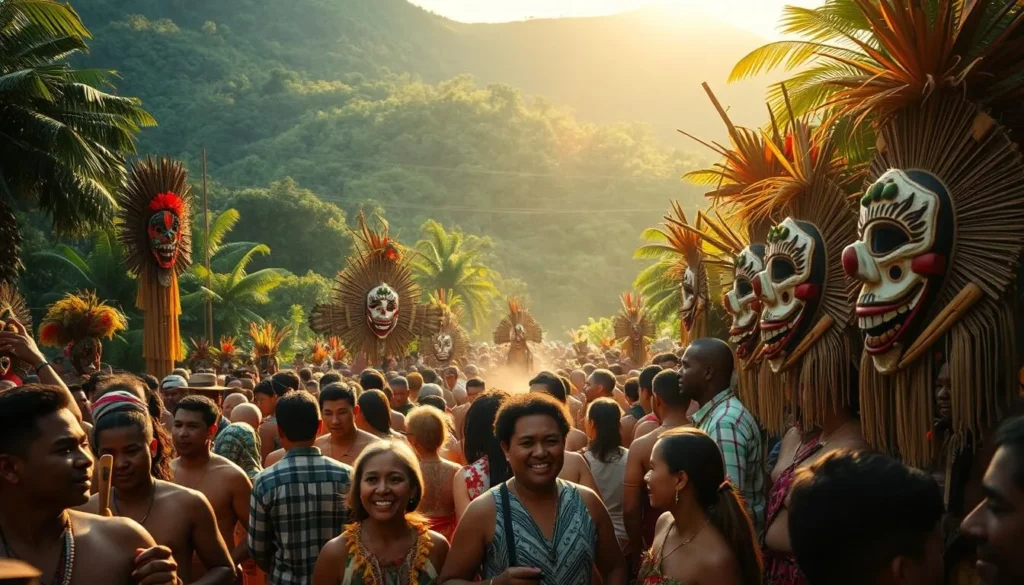
The Goroka Show: Papua New Guinea’s Oldest Cultural Festival
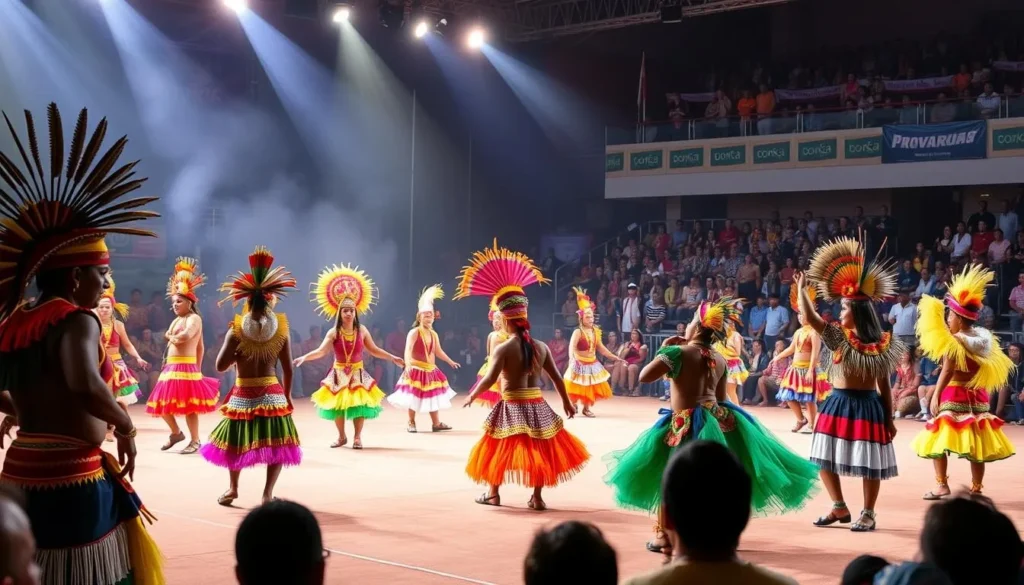
The Goroka Show offers a unique glimpse into Papua New Guinea’s diverse cultural landscape. As the country’s oldest cultural festival, it is a significant event that showcases the traditions and customs of various tribal groups.
History and Significance
The Goroka Show has a rich history, dating back to its inception as a platform for different tribes to come together and celebrate their cultural heritage. It has since become a premier event in Papua New Guinea’s cultural calendar.
The Famous Asaro Mudmen Performance
One of the highlights of the Goroka Show is the performance by the Asaro Mudmen, known for their ferocious display of spear waving and their distinctive grey mud and clay masks.
What to Expect at the Three-Day Event
During the three-day festival, you can expect a variety of performances, including traditional dances and ceremonies. The event typically runs from Friday through Sunday, with increasing intensity of performances each day.
- The main arena features continuous performances throughout the day.
- Early morning arrivals can watch performers prepare for the event.
- Craft markets surrounding the festival grounds offer authentic handicrafts.
- Photography is generally welcomed, but permission should be asked before taking close-up photos.
Mount Hagen Cultural Show: A Highlands Spectacle

The Mount Hagen Cultural Show is a kaleidoscope of color and culture, featuring over 1,000 participants from various Highlands tribes. You will witness a diverse range of performances, including the famous Huli Wigmen, known for their elaborate wigs and yellow-painted faces.
A Vibrant History Since 1961
The Mount Hagen Cultural Show has a rich history dating back to 1961. It has evolved into a premier cultural event, showcasing the traditions and customs of Papua New Guinea’s Highlands region. The show’s long history has made it a significant cultural spectacle, attracting visitors from around the world.
Highlights: Huli Wigmen and Tribal Competitions
The Huli Wigmen are a highlight of the show, with their intricate wigs made from their own hair, decorated with colorful bird-of-paradise feathers and painted with yellow clay. You will also witness various tribal competitions, featuring vibrant costumes and traditional dance performances. The competitive aspect encourages tribes to present their most spectacular displays, making the event a true celebration of Papua New Guinea’s cultural heritage.
Some of the key attractions include:
- The Huli Wigmen, known for their elaborate wigs and distinctive performances.
- Dozens of tribal groups competing with unique body decorations and traditional costumes.
- The opportunity to witness the preparation process, as performers apply paint, arrange feathers, and don their ceremonial attire.
National Mask and Warwagira Festival
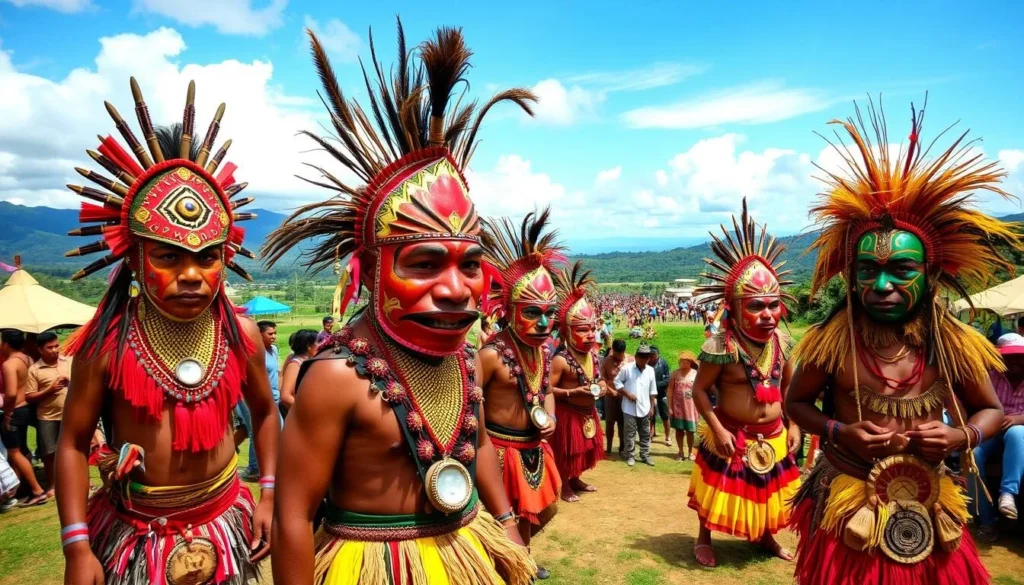
In Papua New Guinea, the National Mask and Warwagira Festival is a must-see event. This vibrant celebration showcases the country’s rich cultural heritage through various performances and rituals.
The Kinavai Ceremony at Dawn
The Kinavai Ceremony, held at dawn, is a significant ritual that marks the beginning of the festival. It is a solemn and spiritual ceremony that sets the tone for the celebrations.
Baining Fire Dance: A Mesmerizing Night Performance
The Baining Fire Dance is a highlight of the festival, featuring dancers from East New Britain. This ancient ritual involves trance-like performances through massive bonfires, showcasing spiritual power and physical endurance.
- The Baining Fire Dance represents one of the most spectacular and physically demanding performances during the National Mask Festival.
- Performed at night by the Baining people of East New Britain, this ancient ritual features dancers wearing enormous bark cloth masks representing spirits of the forest.
- Massive bonfires are built, and as the flames reach their peak, dancers enter a trance-like state and begin leaping through the flames in a display of spiritual power and physical endurance.
As you witness the Baining Fire Dance, you’ll be captivated by the dramatic silhouettes against the flames, creating an unforgettable experience. The festival is a testament to Papua New Guinea’s diverse cultural traditions, including those from New Britain.
Sepik River Crocodile Festival: Honoring the River Spirit

The Sepik River Crocodile Festival is a celebration like no other, deeply rooted in the spiritual beliefs of the Sepik River clans. This unique event is a testament to the rich cultural heritage of Papua New Guinea.
The Cultural Significance of Crocodiles
The crocodile holds a sacred place in the culture of the Sepik River clans, symbolizing power and spiritual connection. The festival celebrates this significance through various rituals and performances.
Traditional Scarification Rituals
One of the most distinctive cultural practices celebrated during the Crocodile Festival is the traditional scarification ritual that marks a boy’s transition to manhood. Young men undergo a painful initiation where their skin is cut in patterns resembling crocodile scales, creating raised scars across their chests and backs.
- One of the most distinctive cultural practices celebrated during the Crocodile Festival is the traditional scarification ritual that marks a boy’s transition to manhood.
- Young men undergo a painful initiation where their skin is cut in patterns resembling crocodile scales, creating raised scars across their chests and backs.
- This ritual symbolizes the spiritual transformation of the initiate, who is believed to take on the power and attributes of the crocodile ancestor through this physical ordeal.
During the festival, recently initiated men proudly display their scarification patterns, which serve as permanent markers of their cultural identity and spiritual transformation.
Kenu and Kundu Festival: Celebrating Maritime Heritage
Set against the stunning backdrop of Milne Bay, one of PNG’s marine biodiversity hotspots, this festival has a South Pacific vibe as canoe races and marine skills celebrate the coastal people’s affinity with the sea.
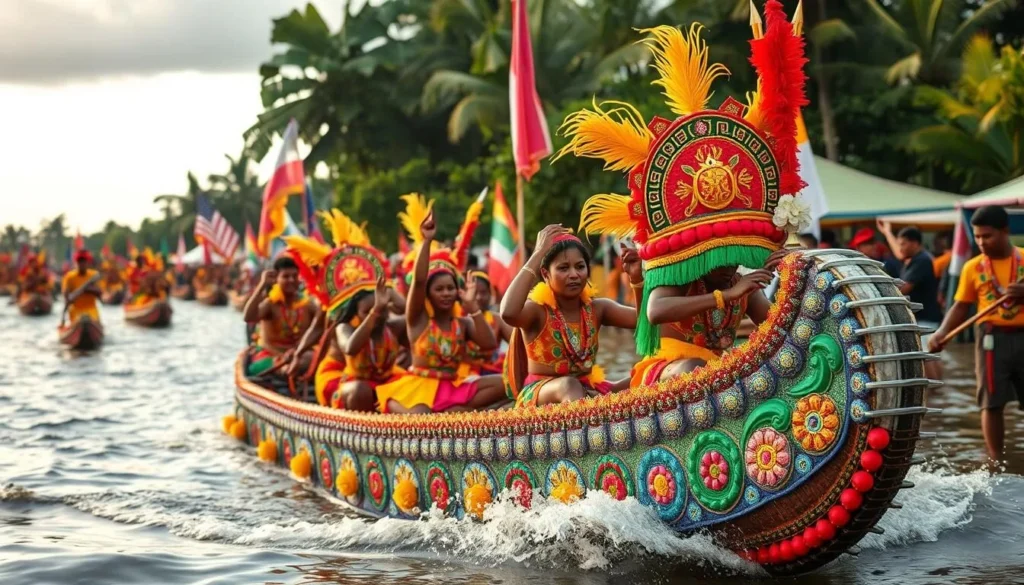
Canoe Races and Sea Skills Demonstrations
The festival features thrilling canoe races and demonstrations of traditional sea skills, showcasing the maritime communities’ expertise and connection with the ocean.
Cultural Performances of Milne Bay Province
The Kenu and Kundu Festival features cultural performances from various island communities, including traditional dancing and music. The kundu drum provides a rhythmic foundation for many performances, telling stories of ancestral voyages and historical events.
- The festival showcases distinctive cultural expressions through movement, costume, and song.
- Many performances tell stories of ancestral voyages, fishing expeditions, or historical events.
- The festival highlights both the shared maritime heritage and distinctive local expressions of Milne Bay Province.
Enga Cultural Show: Highland Traditions
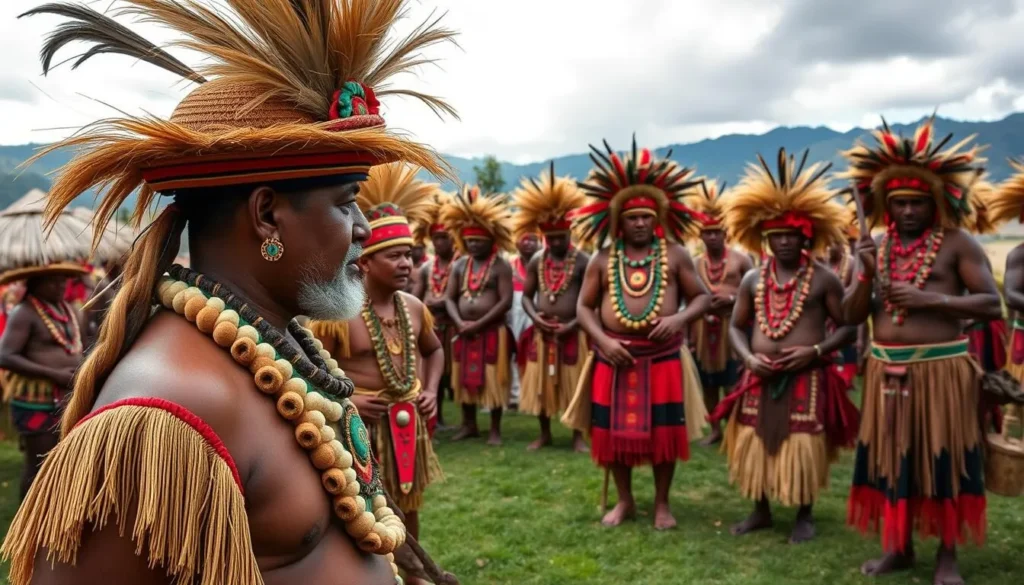
The Enga Cultural Show offers a glimpse into the traditional way of life in Papua New Guinea’s Highlands. You can experience the rich cultural heritage of the Enga people through various performances and demonstrations.
The Sili Mud-Dancers
The Sili Mud-Dancers perform a unique traditional dance, covered in mud, showcasing the traditions of the Enga community.
Traditional Conflict Resolution Ceremonies
The Enga Cultural Show includes demonstrations of traditional conflict resolution ceremonies, such as the “Kunda Kimba” ritual, which highlights the community’s way of resolving disputes through ceremonial pig exchanges and sacrifices, reflecting the complex social structures of highland societies.
Baining Fire Dance Festival: Leaping Through Flames
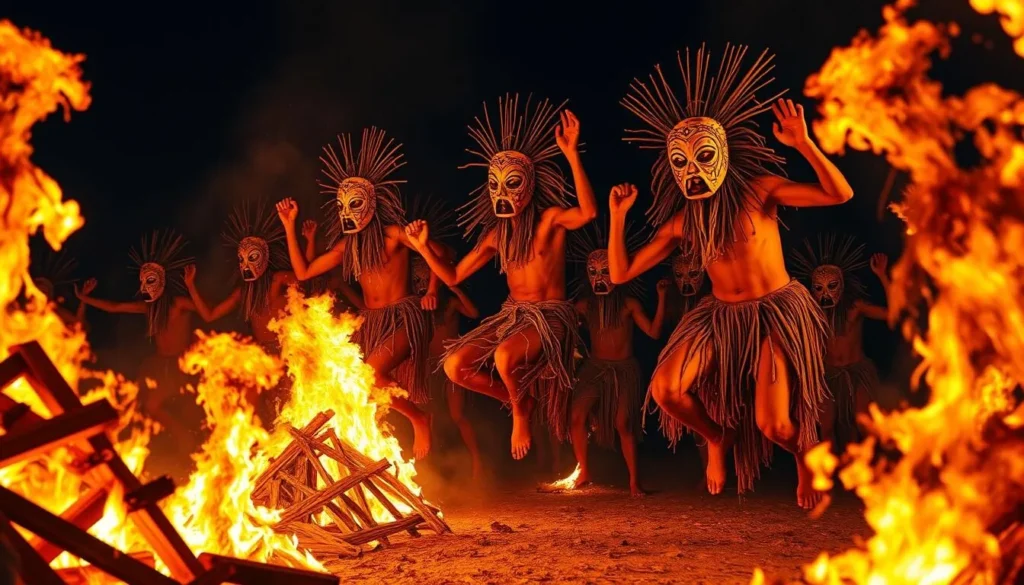
As night falls in East New Britain, the Baining people prepare for a ritual that will leave you breathless. The Baining Fire Dance Festival is a spectacle of spiritual power and physical endurance, where dancers don enormous bark cloth masks representing forest spirits.
Spiritual Significance and Trance-Like Performances
The dance is a deeply spiritual ritual where participants enter a trance-like state, leaping through flames in a display of faith and resilience.
When and Where to Witness This Spectacular Event
You can witness the Baining Fire Dance during the National Mask Festival in July. Performances typically start around 10 PM and continue into the early morning hours, with the most spectacular fire-leaping around midnight.
- The primary location for visitor-accessible performances is near Kokopo in East New Britain Province.
- Travelers should arrange visits through reputable tour operators to ensure a respectful and enriching experience.
- Photography is usually permitted, but be mindful of flash photography to avoid disrupting dancers in trance states.
As a guide to this unique cultural event, it’s essential for visitors to understand the significance of the ritual and to travel responsibly.
Frangipani Festival: Rabaul’s Rebirth Celebration
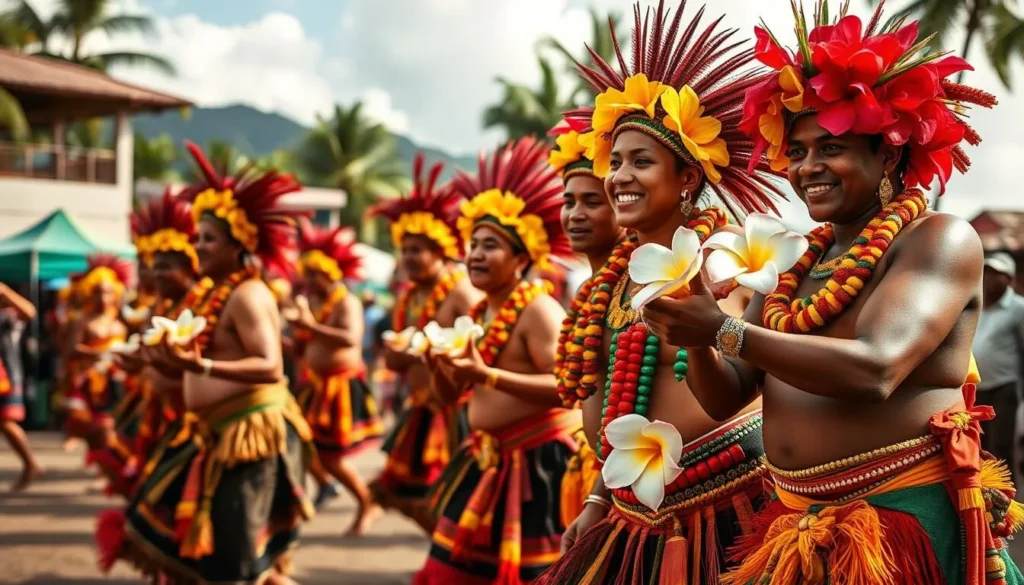
Celebrating Rabaul’s revival, the Frangipani Festival is a must-experience event. This lovely, less hectic affair commemorates the rebirth of the coastal city of Rabaul, which was devastated by several volcanic eruptions of Mt. Tavurvur in 1994.
The festival’s name is derived from the frangipani flower, said to be the first to bloom through the ash that coated the city. The day-long celebration features a variety of cultural performances, including traditional sing-sings, boat races, and culminates in mesmerizing Baining fire-dances.
The Story Behind the Festival
The Frangipani Festival is a testament to the resilience and cultural richness of Rabaul. It celebrates the city’s rebirth and the return of life and vibrancy after the volcanic eruptions.
Tolai Whip Dancers and Community Events
One of the festival’s highlights is the Tolai whip dance, a dramatic initiation ritual where young men endure choreographed lashings as a demonstration of courage and endurance. Various community groups participate in sing-sings, showcasing the cultural diversity of the East New Britain region.
The festival also includes canoe races in the harbor, traditional music performances, and craft demonstrations. As the day concludes, the atmosphere becomes even more electrifying with Baining fire dances as darkness falls, creating a dramatic finale that connects this newer festival to ancient traditions of the region.
Bougainville Chocolate Festival: A Sweet Celebration
On the autonomous island of Bougainville, the Chocolate Festival is a sweet tribute to the island’s cherished cocoa production and cultural traditions.
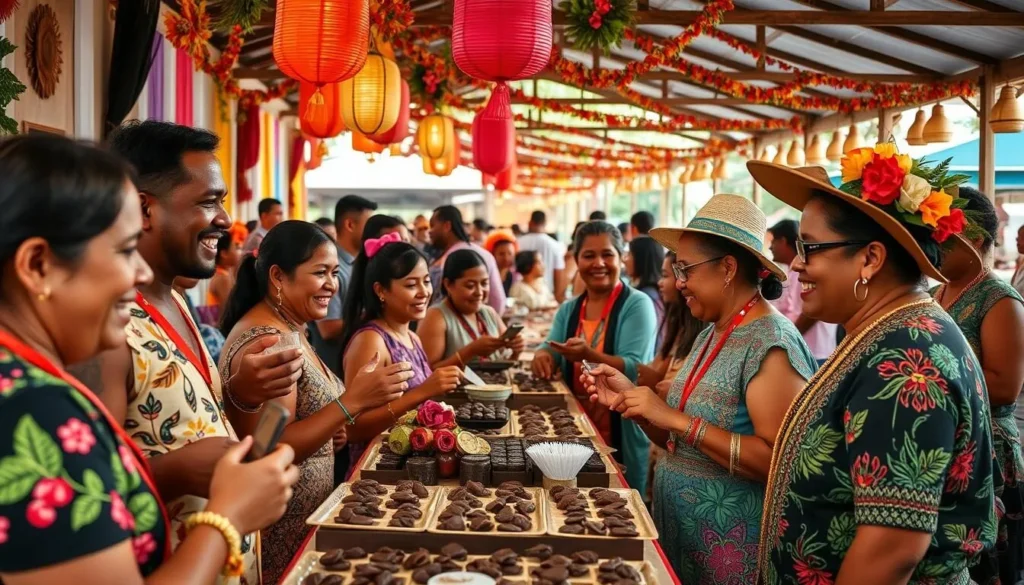
The festival is a unique blend of modern chocolate production and traditional cultural practices. You can experience the island’s rich heritage through various activities.
Cocoa Production and Chocolate Making Demonstrations
The festival features demonstrations on cocoa production and chocolate making, showcasing the process from bean to bar. You can witness the craftsmanship that goes into creating Bougainville’s renowned chocolate.
Cultural Displays and Music Performances
Alongside chocolate making, the festival includes cultural displays and music performances that highlight the island’s traditions. Local dance groups perform traditional dances that narrate stories of Bougainville’s history and the significance of trade and agriculture to the island’s tribes.
The event celebrates the connection between the modern economic activity of chocolate production and the traditional way of life that continues to shape Bougainville’s identity. Through craft displays, live music, and cultural performances, you can immerse yourself in the island’s vibrant heritage.
Tufi Festival: Tattooing and Tapa Cloth
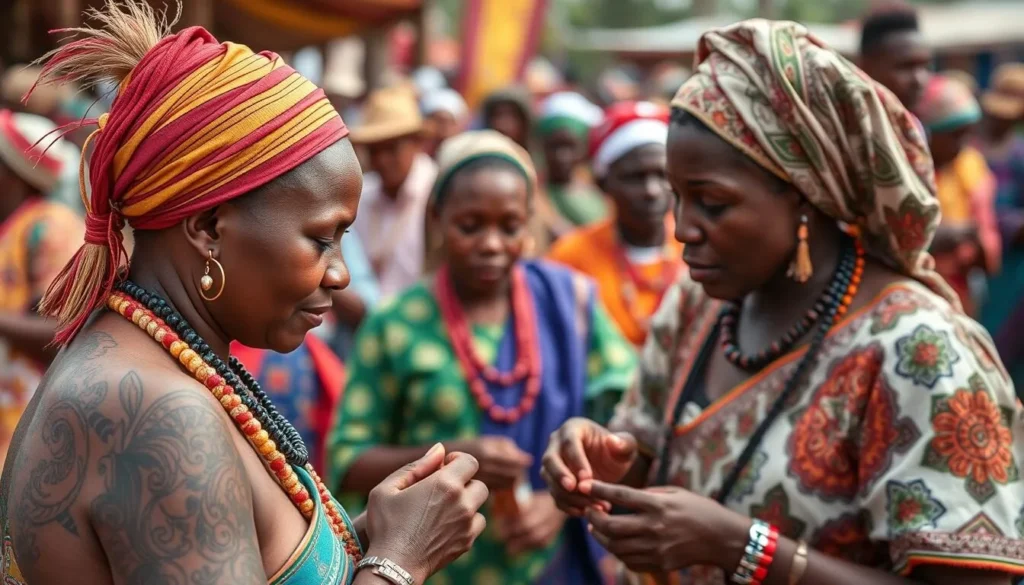
Experience the vibrant culture of the Tufi people at the Tufi Festival, where traditional tattooing and tapa cloth making take center stage. This unique cultural event is a great opportunity for travelers to witness the region’s rich heritage.
Female Facial Tattooing Traditions
Female facial tattooing is a significant tradition among the Tufi people, marking a girl’s transition into womanhood. Visitors can observe this intricate process and understand its cultural significance.
The Art of Tapa Cloth Production
Tapa cloth production is another distinctive cultural tradition showcased at the Tufi Festival. The process involves harvesting and soaking the bark of paper mulberry trees, then beating it with wooden mallets to create thin sheets, which are later decorated with natural pigments.
Essential Tips for Attending Papua New Guinea Festivals
As you prepare to immerse yourself in the vibrant cultures of Papua New Guinea, understanding the essentials can make all the difference. Attending a festival in this culturally rich country can be a rewarding experience, but it requires some preparation.
Cultural Etiquette and Respect
Having a guide can significantly enhance your experience, especially when visiting tribal villages. They help ensure you make a good impression and provide valuable insights into the local culture.
Photography Guidelines
When capturing the beauty of Papua New Guinea’s festivals, be mindful of your surroundings and the people around you. Always ask for permission before taking someone’s photo, as some cultures may have specific beliefs about being photographed.
Practical Travel Advice
To ensure a smooth trip, consider the following tips: Book your accommodations well in advance, especially for major festivals like the Goroka Show and Mount Hagen Cultural Show. It’s also advisable to carry cash in New Guinea Kina, as credit card facilities may be limited. Pack accordingly with sun protection, rain gear, and sturdy footwear. Joining an organized tour can simplify logistics, and purchasing travel insurance that includes medical evacuation coverage is highly recommended.
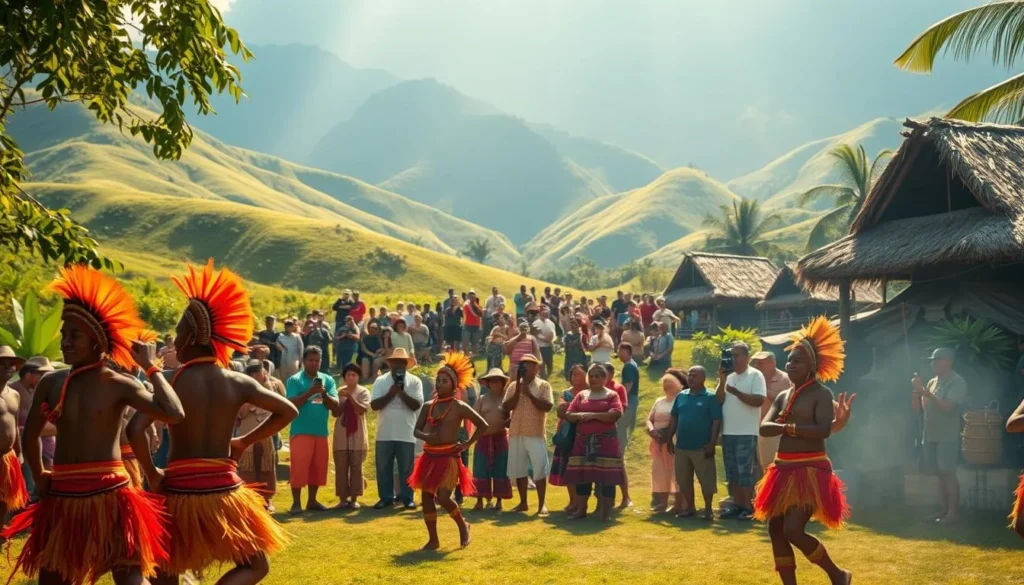
By being prepared and respectful, you can have a meaningful and enjoyable experience at Papua New Guinea festivals.
Conclusion: Experiencing Papua New Guinea’s Top Festivals to Check Out When Visiting
Experiencing Papua New Guinea’s festivals is a journey through the country’s vibrant cultural landscape. You can witness the diversity of Papua New Guinea’s culture through its various festivals, from highland shows to coastal celebrations. These events offer meaningful cultural exchange and understanding, making your travel experience truly enriching. By approaching these festivals with respect and curiosity, you’ll discover the extraordinary living heritage of Papua New Guinea.
The above is subject to change.
Check back often to TRAVEL.COM for the latest travel tips and deals.
